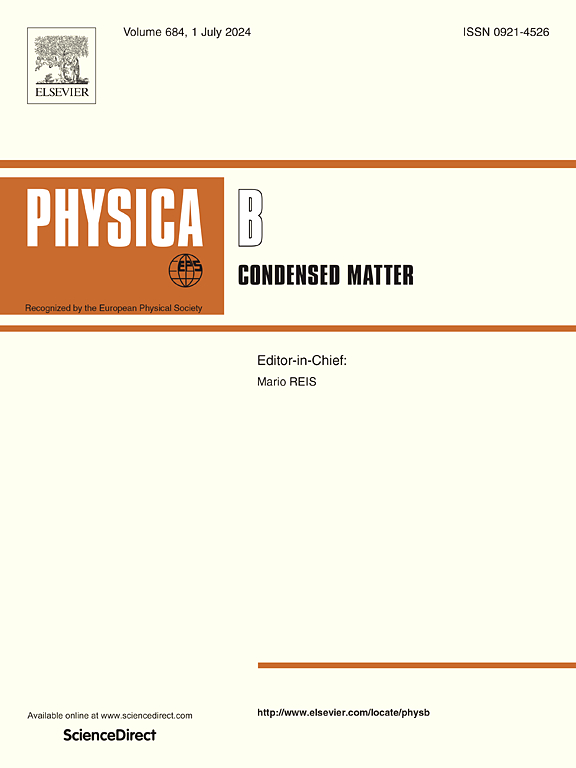Theoretical analysis of Capsicum annuum as natural sensitizer in dye sensitized solar cell using periodic DFT and TD-DFT
IF 2.8
3区 物理与天体物理
Q2 PHYSICS, CONDENSED MATTER
引用次数: 0
Abstract
The dye sensitizers coming from Capsicum annuum, namely capsorubin, capsanthin, and capsaicin, are studied for their application in dye-sensitized solar cells (DSSC). DFT calculations are performed to analyze the DSSC mechanism, especially the photoexcitation and electronic injection step. Absorption spectra describe a band around 450 nm, which originates from a π-π∗ electronic transition associated with the frontier orbitals. This is localized in the large chain of double bonds present in capsorubin and capsanthin. Moreover, the behavior towards adsorption and electron injection of Capsicum annuum to the TiO2 semiconductor is analyzed through the capsorubin@(TiO2)72, capsanthin@(TiO2)72, and capsaicin@(TiO2)72 models. The last one shows a different geometry compared to capsorubin@(TiO2)72 and capsanthin@(TiO2)72. Specifically, the carotenoids capsorubin and capsanthin are bonded to the surface by hydrogen bonds between the methyl substituents and the oxygen atoms of TiO2, while capsaicin loses linearity around the amide group (C-NH-CO 180°), transforming into an angular rearrangement (C-NH-CO 120°). These structural changes influence the electronic injection of Capsicum annuum into the TiO2 semiconductor because the free energy change for the electron injection ( is spontaneous for capsaicin but is not for capsorubin and capsanthin. Thus, the efficiency is controlled by the presence of weak interactions in this type of sensitizer.
利用周期离散傅里叶变换和td -离散傅里叶变换理论分析了辣椒作为染料敏化太阳能电池天然敏化剂的作用
研究了从辣椒中提取的染料敏化剂辣椒素、辣椒素和辣椒素在染料敏化太阳能电池(DSSC)中的应用。通过DFT计算分析了DSSC的机理,特别是光激发和电子注入步骤。吸收光谱描述了一个约450 nm的波段,它起源于与前沿轨道相关的π-π *电子跃迁。这是定位在大链双键存在于辣椒素和辣椒素。此外,通过capsorubin@(TiO2)72、capsanthin@(TiO2)72和capsaicin@(TiO2)72模型分析了辣椒素@(TiO2)72对TiO2半导体的吸附和电子注入行为。与capsorubin@(TiO2)72和capsanthin@(TiO2)72相比,最后一个显示了不同的几何形状。具体来说,类胡萝卜素capsorubin和辣椒素通过甲基取代基和TiO2氧原子之间的氢键与表面结合,而辣椒素在酰胺基(C-NH-CO 180°)周围失去线性,转变为角度重排(C-NH-CO 120°)。这些结构变化影响了辣椒素在TiO2半导体中的电子注入,因为电子注入的自由能变化(ΔGinj)对于辣椒素是自发的,而对于capsorubin和辣椒素则不是。因此,在这种类型的敏化剂中,效率是由弱相互作用的存在控制的。
本文章由计算机程序翻译,如有差异,请以英文原文为准。
求助全文
约1分钟内获得全文
求助全文
来源期刊

Physica B-condensed Matter
物理-物理:凝聚态物理
CiteScore
4.90
自引率
7.10%
发文量
703
审稿时长
44 days
期刊介绍:
Physica B: Condensed Matter comprises all condensed matter and material physics that involve theoretical, computational and experimental work.
Papers should contain further developments and a proper discussion on the physics of experimental or theoretical results in one of the following areas:
-Magnetism
-Materials physics
-Nanostructures and nanomaterials
-Optics and optical materials
-Quantum materials
-Semiconductors
-Strongly correlated systems
-Superconductivity
-Surfaces and interfaces
 求助内容:
求助内容: 应助结果提醒方式:
应助结果提醒方式:


